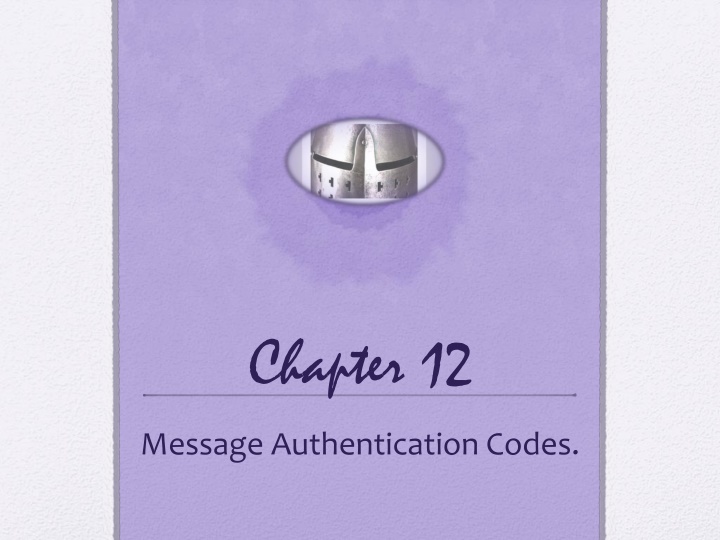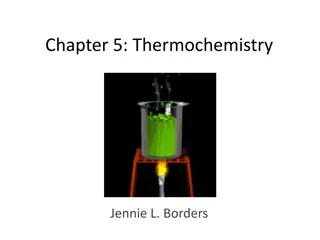Chapter 12
Message authentication codes play a critical role in ensuring the security of communication by protecting against various attacks like message tampering, disclosure, and modification. Public-key encryption and requirements for MACs are essential components for implementing secure authentication mechanisms. Understanding the significance of authentication codes is crucial for maintaining data integrity and confidentiality in digital communications.
Download Presentation

Please find below an Image/Link to download the presentation.
The content on the website is provided AS IS for your information and personal use only. It may not be sold, licensed, or shared on other websites without obtaining consent from the author.If you encounter any issues during the download, it is possible that the publisher has removed the file from their server.
You are allowed to download the files provided on this website for personal or commercial use, subject to the condition that they are used lawfully. All files are the property of their respective owners.
The content on the website is provided AS IS for your information and personal use only. It may not be sold, licensed, or shared on other websites without obtaining consent from the author.
E N D
Presentation Transcript
Chapter 12 Message Authentication Codes.
Message Authentication Requirements Disclosure Sequence modification Release of message contents to any person or process not possessing the appropriate cryptographic key Any modification to a sequence of messages between parties, including insertion, deletion, and reordering Traffic analysis Timing modification Discovery of the pattern of traffic between parties Delay or replay of messages Masquerade Source repudiation Insertion of messages into the network from a fraudulent source Denial of transmission of message by source Destination repudiation Content modification Denial of receipt of message by destination Changes to the contents of a message, including insertion, deletion, transposition, and modification
Public-Key Encryption The straightforward use of public-key encryption provides confidentiality but not authentication To provide both confidentiality and authentication, A can encrypt M first using its private key which provides the digital signature, and then using B s public key, which provides confidentiality Disadvantage is that the public-key algorithm must be exercised four times rather than two in each communication
Requirements for MACs The final requirement dictates that the authentication algorithm should not be weaker with respect to certain parts or bits of the message than others The first requirement deals with message replacement attacks, in which an opponent is able to construct a new message to match a given MAC, even though the opponent does not know and does not learn the key The second requirement deals with the need to thwart a brute-force attack based on chosen plaintext Taking into account the types of attacks, the MAC needs to satisfy the following:
Brute-Force Attack Requires known message-tag pairs A brute-force method of finding a collision is to pick a random bit string y and check if H(y) = H(x) Two lines of attack: Attack the key space If an attacker can determine the MAC key then it is possible to generate a valid MAC value for any input x Attack the MAC value Objective is to generate a valid tag for a given message or to find a message that matches a given tag
Cryptanalysis Cryptanalytic attacks seek to exploit some property of the algorithm to perform some attack other than an exhaustive search An ideal MAC algorithm will require a cryptanalytic effort greater than or equal to the brute-force effort There is much more variety in the structure of MACs than in hash functions, so it is difficult to generalize about the cryptanalysis of MACs
MACs Based on Hash Functions: HMAC There has been increased interest in developing a MAC derived from a cryptographic hash function Motivations: Cryptographic hash functions such as MD5 and SHA generally execute faster in software than symmetric block ciphers such as DES Library code for cryptographic hash functions is widely available HMAC has been chosen as the mandatory-to- implement MAC for IP security Has also been issued as a NIST standard (FIPS 198)
HMAC Design Objectives RFC 2104 lists the following objectives for HMAC: To use, without modifications, available hash functions To allow for easy replaceability of the embedded hash function in case faster or more secure hash functions are found or required To preserve the original performance of the hash function without incurring a significant degradation To use and handle keys in a simple way To have a well understood cryptographic analysis of the strength of the authentication mechanism based on reasonable assumptions about the embedded hash function
HMAC Structure ???? ?,? = ?[(?+ ????) ?[(?+ ????) ?]]
Security of HMAC Depends in some way on the cryptographic strength of the underlying hash function Appeal of HMAC is that its designers have been able to prove an exact relationship between the strength of the embedded hash function and the strength of HMAC Generally expressed in terms of the probability of successful forgery with a given amount of time spent by the forger and a given number of message-tag pairs created with the same key
Authenticated Encryption (AE) A term used to describe encryption systems that simultaneously protect confidentiality and authenticity of communications Approaches: Hash-then-encrypt: E(K, (M || h)) MAC-then-encrypt: T = MAC(K1, M), E(K2, [M || T]) Encrypt-then-MAC: C = E(K2, M), T = MAC(K1, C) Encrypt-and-MAC: C = E(K2, M), T = MAC(K1, M) Both decryption and verification are straightforward for each approach There are security vulnerabilities with all of these approaches
Counter with Cipher Block Chaining- Message Authentication Code (CCM) Was standardized by NIST specifically to support the security requirements of IEEE 802.11 WiFi wireless local area networks Variation of the encrypt-and-MAC approach to authenticated encryption Defined in NIST SP 800-38C Key algorithmic ingredients: AES encryption algorithm CTR mode of operation CMAC authentication algorithm Single key K is used for both encryption and MAC algorithms
The input to the CCM encryption process consists of three elements: Associated data A that will be authenticated but not encrypted A nonce N that is assigned to the payload and the associated data Data that will be both authenticated and encrypted This is a unique value that is different for every instance during the lifetime of a protocol association and is intended to prevent replay attacks and certain other types of attacks An example is a protocol header that must be transmitted in the clear for proper protocol operation but which needs to be authenticated This is the plaintext message P of the data block
Galois/Counter Mode (GCM) NIST standard SP 800-38D Designed to be parallelizable so that it can provide high throughput with low cost and low latency Message is encrypted in variant of CTR mode Resulting ciphertext is multiplied with key material and message length information over GF (2128) to generate the authenticator tag The standard also specifies a mode of operation that supplies the MAC only, known as GMAC Makes use of two functions: GHASH - a keyed hash function GCTR - CTR mode with the counters determined by simple increment by one operation
Pseudorandom Number Generation Using Hash Functions and MACs Essential elements of any pseudorandom number generator (PRNG) are a seed value and a deterministic algorithm for generating a stream of pseudorandom bits If the algorithm is used as a pseudorandom function (PRF) to produce a required value, the seed should only be known to the user of the PRF If the algorithm is used to produce a stream encryption function, the seed has the role of a secret key that must be known to the sender and the receiver A hash function or MAC produces apparently random output and can be used to build a PRNG





















